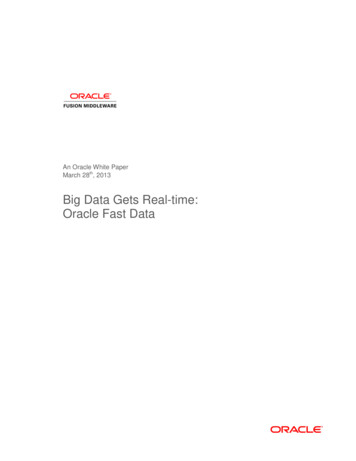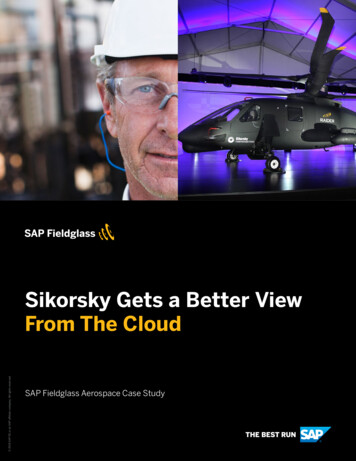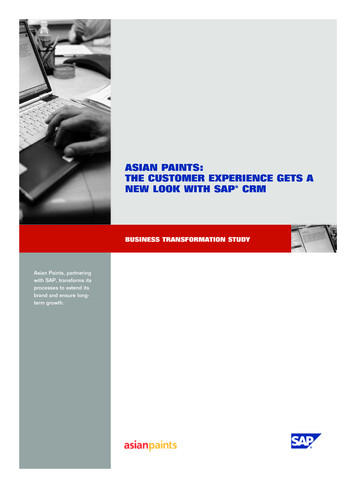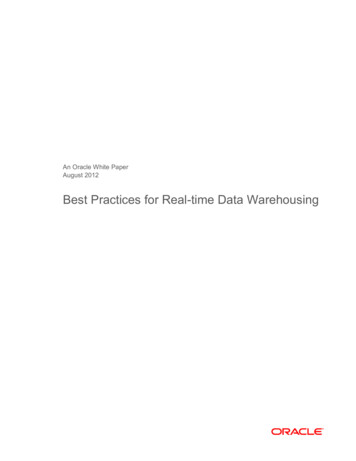
Transcription
An Oracle White PaperMarch 28th, 2013Big Data Gets Real-time:Oracle Fast Data
Big Data Gets Real-timeDisclaimerThe following is intended to outline our general product direction. It is intended for information purposesonly, and may not be incorporated into any contract. It is not a commitment to deliver any material, code,or functionality, and should not be relied upon in making purchasing decisions. The development, release,and timing of any features or functionality described for Oracle’s products remains at the sole discretionof Oracle.
Connecting Visibility to ValueWhat is Fast Data? . 2Fueling the Demand for Velocity Solutions . 3Are You Running your Business Fast Enough? . 3Fast Data across Industries . 5Financial Services Industry . 5Logistics/Travel . 5Public Sector . 5Telco . 6Energy . 6Manufacturing . 6Customer Experience / Retail . 6Healthcare . 7Oracle’s Solution for Fast Data . 7Oracle Event Processing and Oracle Coherence. 8Oracle Data Integration . 10Fast Data and Oracle’s Real-time Data Integration . 10Oracle Business Analytics . 11Oracle Real Time Decisions . 11Oracle Business Intelligence Foundation . 12Oracle Endeca Information Discovery . 12Oracle Fast Data on Engineered Systems . 12Oracle Event Processing with Oracle Coherence on Oracle ExalogicOracle Data Integration and Oracle Exadata Database Machine . 13Oracle Business Analytics and Oracle Exalytics . 14Summary . 1413
Connecting Visibility to ValueWhat is Fast Data?To Today, both IT and business users alikeare facing business scenarios where theyneed better information to differentiate,innovate, and radically transform theirbusiness. In many cases, that transformationis being enabled by a move to “Big Data.”Organizations are increasingly collecting vastquantities of real-time data from a variety ofsources, from online social media data to highly-granular transactional data to data fromembedded sensors. Once collected, users or businesses are mining the data for meaningfulpatterns that can be used to drive business decisions or actions.Big Data uses specialized technologies (like Hadoop and NoSQL) to process vast amounts ofinformation in bulk. But most of the focus on Big Data so far has been on situations where thedata being managed is basically fixed—it’s already been collected and stored in a Big DatadatabaseThis is where fast data comes in. Fast data is a term that was coined recently by Ovum’s TonyBaer who said, “Fast Data, the velocity side of Big Data, is not new, but technologyprice/performance trends are making Fast Data applications more widely available”.1“Fast data is a complimentary approach to big data” writes Hasan Rizvi, “for managing largequantities of “in-flight” data that helps organizations get a jump on those business-criticaldecisions. Fast data is the continuous access and processing of events and data in real-timefor the purposes of gaining instant awareness and instant action. Fast data can leverage bigdata sources, but it also adds a real-time component of being able to take action on events2and information before they even enter a Big Data system.”12“What is Fast Data”, Tony Baer, Ovum, Nov 2012Fast Data Gets A Jump On Big Data, Forbes, Hasan Rizvi, March 1st, 20132
Connecting Visibility to ValueFueling the Demand for Velocity SolutionsThere are a couple of reasons why the appeal of fast data has grown. As increased volumes ofdata become commonplace across many industry sectors, the value of applying a fast datastrategy as an end-to-end solution has become more apparent. For instance, the Big Data3Market is 5 billion growing at 58% CAGR over next 5 years to reach 50 billion . This clearlyan indication that volumes, varieties and consequently the velocity of data is on the rise.Secondly, customer touch points are increasing. As the membership to online socialcommunities continues to skyrocket, so does the demand for instantaneous responsiveness aswell as improved customer experiences. Fast data means getting the most current informationto customers, customer service representatives, and business analysts in a timely manner.Finally, another factor which has fueled the demand for velocity solutions is the internet ofthings. There are more devices than ever before. In fact we’re seeing an explosion in the4number of devices over the next 5 years by 22X. There’s now more connectivity of all of thisinformation that we can take advantage of in real-time. As more and more devices come onboard we’re also seeing an uptake in solutions that require device to datacenter (D2D); fastdata is an important element in connecting streams of data together from device to thedatacenter. This data that exists beyond the companies four walls can also be tapped – andwhen it is tapped it’s important to keep only the most current information. For example,sensors within a city center can help first responders react faster in a storm or a criticalsituation.Are You Running your Business Fast Enough?While speeds and feeds do not usually justify a business case alone, in this case speed is thebusiness case. By capturing data faster, being able to move data faster, means analyzing itand acting on it faster. Today more and more cases within IT are demanding the elimination oflatency as part of solving a business problem. Data loses value at a faster rate and3http://wikibon.org/wiki/v/Big Data Market Size and Vendor Revenues4CISCO VNI Mobile 20123
Connecting Visibility to Valueconsequently the value you get from your data diminishes when you don’t tap into it soonenough. The following are four key drivers that we’re seeing when it comes to fast datasolutions: To build new services –organizations need to have direct insights into their data. Forexample: building a location based offer requires a collection of real-time information,geo-spatial technologies, as well as marketing data. To improve customer experience –companies need instant access to customerinformation, claims transactions, support information, social media metrics To improve efficiencies – This could be hardware offloading costs, or improved assetutilization by faster data processing. To develop higher quality in operations –one needs to look at using operationaldata for an advantage. For example, by collecting events fast and eliminating latenciesfor reporting companies can shorten their supply chain cycles while reducing gaps inkey business processes.4
Connecting Visibility to ValueFast Data across IndustriesFinancial Services IndustryOne of the most traditional styles of fast data is using event correlation to contextualizeavailable financial data. This can inform trading behavior, specifically algorithmic trading, byidentifying opportunities or threats that indicate traders (or automatic trading systems) shouldbuy or sell. Algorithmic trading is a growing trend in competitive financial markets. Today, awide variety of financial applications use event processing technologies, including profit, loss,and risk management systems, order and liquidity analysis, quantitative trading and signalgeneration systems, and others. The growing trend in this industry is to expand not only theuse of event processing technologies but also real-time data integration and analytics as well.Logistics/TravelFast data solutions help monitor all airline's operational events, from passenger check-in,baggage handling (bag on conveyor, bag off conveyor, bag loaded on ULD, ULD loaded onplane, etc.), and flight operations (flight leaves gate, flight lands, etc.). By applying a fast dataapproach, an airline can better ensure that the right bags get loaded correctly, ensure thatflights leave the gate and take off on time, and ultimately manage airline operations in anintelligent, automated way.Public SectorFast Data solutions help public sector organizations respond faster to incidents as they occurin city centers across a range of scenarios: informational, criminal, and terrorist incidents. Bybeing able to correlate and filter a vast number of events (which rapidly decay in value over5
Connecting Visibility to Valuetime) city centers can support comprehensive real-time data collection and analysis for realtime intelligent traffic management, forensic analysis, vehicle journey history, traffic hotspots,crime density.TelcoMany Telco organizations are faced by the challenges of managing their resources effectively,optimizing capital expenditure (CAPEX) on network infrastructure while lowering or maintainingoperational expenditure (OPEX). This requires the ability to gain insights as they occur tounderstand allocation of network resources based on traffic and application requirements,network usage patterns. Ultimately, fast data can help gain real-insights based on hard data asit comes in, not just approximate trending.EnergyEnergy organizations that have implemented smart grid or smart metering may be utilizing acombination of devices and high volume of events which are delivered over a vast network;these events need to be correlated and processed in real-time to make important real-timedecisions. For example, would the Northeast blackout actually have occurred if the rightsystems had detected the alarms on time? What would have been a manageable localblackout cascaded into widespread distress on the electric grid.5ManufacturingCapture events from business applications, manufacturing systems, and other process devicesand proving real-time dashboards and actionable analysis. Control and monitor operations,analyze real-time metrics that for immediate results to take corrective action before a failureoccurs. Recognizing the need for maintenance can save in repair costs and costly delays.Customer Experience / RetailCustomer service centers are using Fast Data for click-stream analysis and customerexperience management. Fast Data can factor real-time information about millions of events(clicks or other interactions) per second into business intelligence and other decision-supportapplications. These "recommendation applications" help agents provide personalized service5http://en.wikipedia.org/wiki/Northeast blackout of 20036
Connecting Visibility to Valuebased on each customer's experience. Click-stream analysis can help target offers and eveninitiative customer service interactions. For example “it looks like you’re having difficultydeciding which camera to purchase would you like to chat online with a technicalrepresentative?”).HealthcareAnother example of Fast Data in practice is in the healthcare industry. One example, is theHyReminder system, developed by the Worcester Polytechnic Institute and UMass MedicalSchool, continually tracks healthcare workers for hygiene compliance (e.g. sanitizing handsand wearing masks), reminding them to perform hygiene when appropriate to prevent thespread of infectious disease. Each worker wears an RFID badge that displays a green (safe),yellow (warning) or red (violation) light, depending on what behavior the RFID chip hasobserved.Oracle’s Solution for Fast DataOracle’s Fast Data solutions offer multiple technologies that work hand-in-hand to create valueout of high-velocity, high-volume data. They are designed to optimize the efficiency, scale forprocessing high volume events and transactions. Filter and Correlate. With Oracle Event Processing you can use predefined rules tofilter and correlate data through big data sources. In addition, this solution has theadvantage that it can run in-memory to optimize performance, scale by integrating withOracle Coherence.7
Connecting Visibility to Value Move and Transform. With Oracle Data Integrator and Oracle GoldenGate you cancapture data (structured or unstructured) and immediately move information where it isneeded—and in the right format—to best support decision making. Analyze. Oracle Business Analytics enable you to discover what’s possible for realtime analysis. Act. Oracle Real-time Decisions together with Oracle BPM, helps support bothautomated decision-making as well as more complex, human-based interactions, suchas business process management.All of these components run on a rich data tier environment which supports both: Big DataHadoop/NoSQL, as well as SQL, and scales elastically on standards based Java platforms.Only Oracle has a complete and integrated solution with the best-of-breed components when itcomes to processing events, data, and analytics in real time. And, only Oracle can run thesefast data components on diverse deployment architectures, including device gateways, bigdata environments, or engineered systems.Oracle Event Processing and Oracle CoherenceOracle Event Process
An Oracle White Paper March 28th, 2013 Big Data Gets Real-time: Oracle Fast Data










